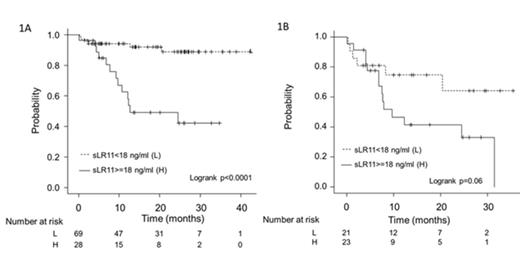Abstract
Introduction: LR11 is a type I membrane protein that plays a key role in the migration of undifferentiated vascular smooth muscle cells, and circulating soluble LR11 (sLR11) has been known as a biomarker for coronary stenosis. We have previously found that LR11 is highly expressed in acute leukemia, diffuse large B cell lymphoma (DLBCL), and follicular lymphoma (FL) cells. Soluble LR11 were detected in the patients' serum, and our retrospective cohort demonstrated that serum sLR11 level is significantly increased at diagnosis and normalized at remission (Sakai et al. Clin Chim Acta. 2012, Ohwada et al. 2011 ASH annual meeting). Furthermore, high serum sLR11 level had a significant association with relapse and inferior progression-free survival (PFS) in patients with FL (Kawaguchi et al. Br J Haematol. 2013). Based on these findings, we have conducted a multicenter prospective observational study to validate the clinical impact of serum sLR11 in patients with newly diagnosed DLBCL.
Patients and Methods: Ninety-seven consecutive patients with newly diagnosed DLBCL between 2010 and 2013 in Chiba University Hospital and affiliated hospitals were enrolled. Serum samples were collected at diagnosis and when the patients reached complete remission. Clinical and laboratorial data were collected prospectively. Serum sLR11 levels were measured with enzyme-linked immunosorbent assay. Normal control samples were obtained from 75 healthy adult volunteers who had given informed consent.
Results: The patients had a median age of 69 years (range, 18-94). Ninety percent of patients were treated with R-CHOP-based regimen, and 80% of them achieved complete remission (CR). Serum sLR11 levels of DLBCL patients were significantly elevated than those of normal controls (21.2 ±27.6 ng/ml vs. 8.8 ±1.8 ng/ml, p<0.0001), and paired sample analysis showed elevated serum sLR11 level at diagnosis was significantly decreased at complete remission (17.4 ± 16.4 ng/ml vs. 11.0 ± 4.2 ng/ml, p=0.0008). Serum sLR11 levels were significantly high in "poor" risk patients categorized by Revised-International Prognostic Index (R-IPI) (poor vs. very-good/good: 33.0 ± 37.1 ng/ml vs. 11.0 ± 4.2 ng/ml, p<0.0001), and also in those with bone marrow invasion (present vs. absent: 48.7 ± 59.5 ng/ml vs. 17.0 ± 15.3 ng/ml, p=0.01). Multiple stepwise liner regression analysis revealed that serum sLR11 level at diagnosis was independently associated with serum LDH and beta-2-microgloblin levels (B2MG) (r2=0.43, serum LDH: p=0.0007, serum B2MG: p<0.0001). At the median follow-up period of 13.8 months, 2-year progression free survival (PFS) and overall survival (OS) were significantly inferior in patients with serum sLR11 >=18 ng/ml, compared to those with < 18 ng/ml (2-year PFS: 47% vs. 85%, p<0.0001, 2-year OS: 49% vs. 89%, p<0.0001). Furthermore, among 44 poor-risk patients determined by R-IPI, patients with serum sLR11 >=18 ng/ml showed a trend toward lower PFS than those with <18 ng/ml (2-year PFS: 41% vs. 64%, p=0.06).
Conclusion: Here we have prospectively validated that serum sLR11 is a simple and powerful indicator of tumor burden and aggressive disease character with poor prognosis. By combining with previously established prognostic indexes, sLR11 may enable us to identify high-risk patients who are candidates for more aggressive treatment strategy such as up-front autologous stem cell transplantation, or combination of novel targeted agents.
Figure 1A. OS according to serum sLR11 at diagnosis. Figure 1B. PFS in patients with "Poor" R-IPI risk, according to serum sLR11 at diagnosis.
Figure 1A. OS according to serum sLR11 at diagnosis. Figure 1B. PFS in patients with "Poor" R-IPI risk, according to serum sLR11 at diagnosis.
No relevant conflicts of interest to declare.
Author notes
Asterisk with author names denotes non-ASH members.


This feature is available to Subscribers Only
Sign In or Create an Account Close Modal